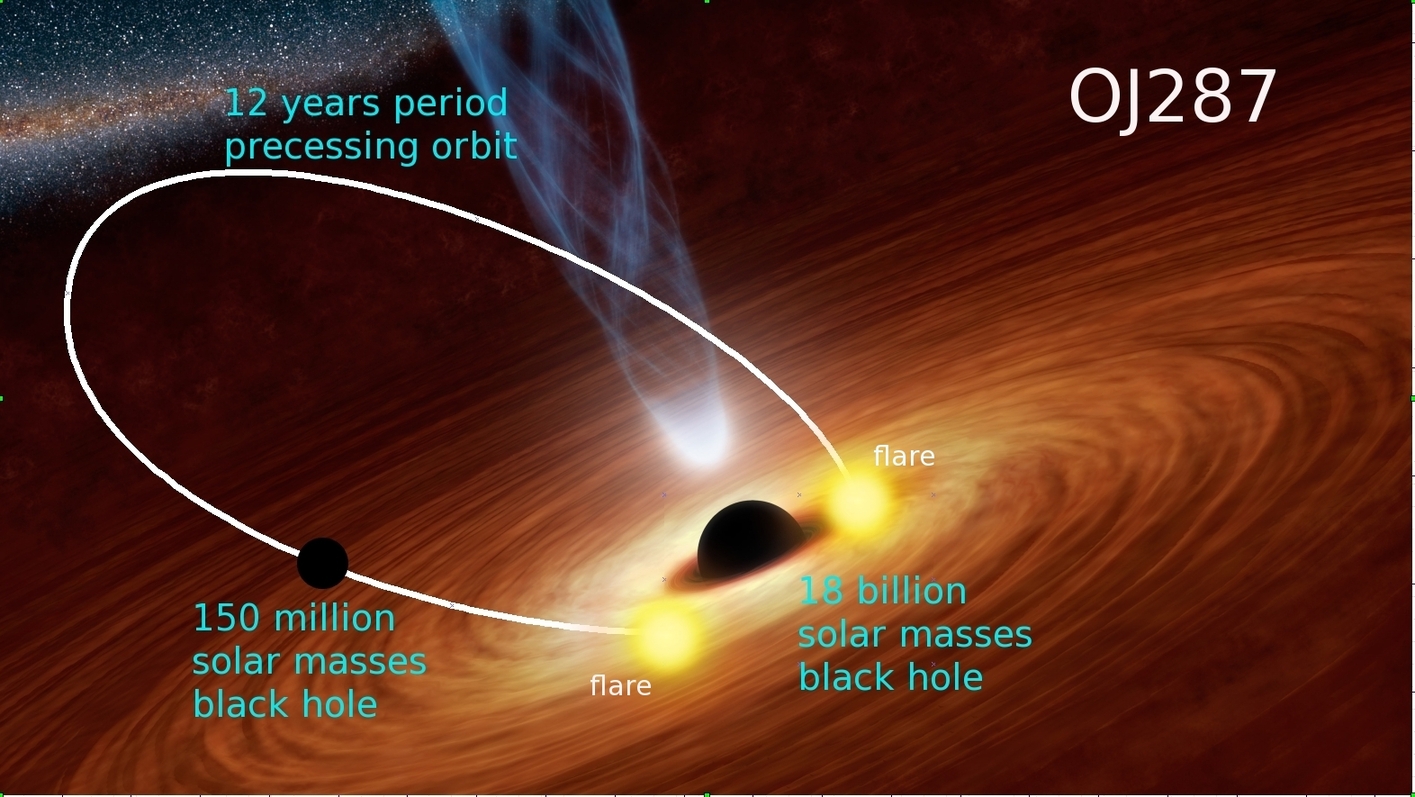Astronomy Object of the Month: 2023, July
< previous Archive next >
Finally, we have direct evidence of a pair of black holes at the center of the galaxy OJ 287
Scientists, including a team of Professor Stanislaw Zola from the Jagiellonian University's Astronomical Observatory in Krakow, Poland, are not stopping their studies of the active galaxy OJ 287. The results of the international team led by Professor Mauri Valtonen from the University of Turku (Finland), announced at the 242nd meeting of the American Astronomical Society and described in the latest issue of the scientific journal Monthly Notices of the Royal Astronomical Society, bring startling information regarding the detection of a signal generated by a second supermassive black hole located at the center of this distant galaxy.

Illustration 1: The dance of two... black holes – a large one (at the very center) and a small one (in the orbit with a period of about 12 years).
OJ 287 is a blazar, a specific type of active galaxy. It is located nearly 5 billion light years away from us. Its position in the sky is crucial here: the object is located in the constellation of Cancer, which is part of the ecliptic. Near it are the orbits of the planets of the Solar System. Since long time astronomers have searched for new planets and other small bodies in this particular area, and starting from the end of the 19th century they started systematically photographing this region. Reviewing the old photographic plates, researchers discovered that the light coming from OJ 287 was unknowingly recorded for the first time as early as in 1888.
By studying the variability of the visible light of this distant system, possible today on a unique time scale of more than a century, we can learn details of its structure and evolution. Astronomers have identified two basic cycles. One, repeating every 55 years, is associated with a slow change in the orientation of the entire system. The second, which repeats about every 12 years, is accompanied by flares that last about two weeks. To explain such unusual variability, particularly the rapid periodic brightenings, one had to postulate the existence at the center of OJ 287 not of a single, as is usually the case with almost all active galaxies, but of a pair of supermassive black holes, fundamentally different in size. The main black hole, with a mass as large as 18 billion Suns, is surrounded by a disk from which it slowly "sucks up" the matter. This supermassive black hole also generates energetic, highly collimated outflows of matter, accompanied by electromagnetic radiation observed on Earth. A second "relatively small" black hole with a mass of "only" 150 million solar masses orbits its companion and periodically punctures its disk twice - accompanied by some spectacular light fireworks.
For decades, scientists have been trying to resolve individual contributions from each black hole in the observed light. If successful, they could confirm the existence of two massive components. Theoretical models of the behavior of the tight system of a pair of black holes provided predictions of the occurrence of subsequent flares. The predictions came true time and again. However, astronomers were still looking for firm evidence of the existence of a less massive black hole.
In 2021 and 2022, an international team led a large-scale campaign of multi-band observations of OJ 287. The reason was the prediction of the imminent "plunge" of the less massive black hole into the accretion disk. In fact, less than a few nights after the predicted date, Professor S. Zola, using Skynet telescopes scattered around the world, actually observed a brief flare. It lasted only one day! While piercing the accretion disk, the "small" black hole absorbed a large dose of matter. This caused a sudden brightening of the entire system. Such a short-lived phenomenon is easy to miss! The success of the project was largely due to prof. Zola's great observational and coordination experience and... a cloudless night in those parts of the world where the observations were carried out. At a similar time, the brightening of the system at gamma waves was detected by the Fermi satellite. In addition, a longer-lasting increase in the optical brightness of OJ287 takes place when the black hole is getting out over the disk.
Taking it all together, astronomers have determined that these three types of flares are evidence of a direct interaction between a small-mass companion and the accretion disk surrounding the more massive black hole.

Illustration 2:
The light curve (in visible light) of blazar OJ 287. Two cycles are evident: a 55-year one (red) and a 12-year cycle (shown in black). The dots represent single luminosity measurements. Noticeable increase in the frequency of observations occurred in the 1970s and continues to this day.
Credit: The Authors.
Original publication: Valtonen, Mauri J.; Zola, Staszek et al., Refining the OJ 287 2022 impact flare arrival epoch, Monthly Notices of the Royal Astronomical Society, Volume 521, Issue 4 (2023)
The research was conducted at the Department of Stellar and Extragalactic Astronomy of the Jagiellonian University’s Astronomical Observatory (OA UJ).
Contact:
Original publication: Valtonen, Mauri J.; Zola, Staszek et al., Refining the OJ 287 2022 impact flare arrival epoch, Monthly Notices of the Royal Astronomical Society, Volume 521, Issue 4 (2023)
The research was conducted at the Department of Stellar and Extragalactic Astronomy of the Jagiellonian University’s Astronomical Observatory (OA UJ).
|
Stanisław Zoła Astronomical Observatory Jagiellonian University S.Zola[@]oa.uj.edu.pl |


